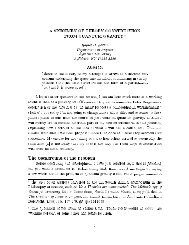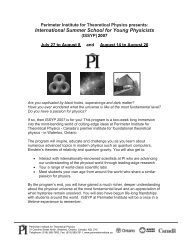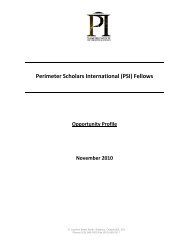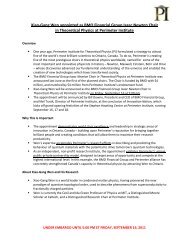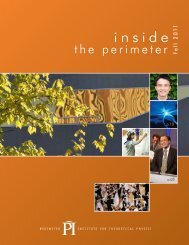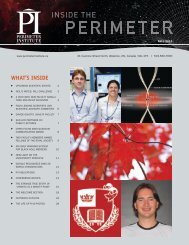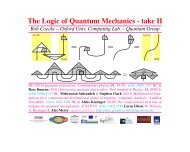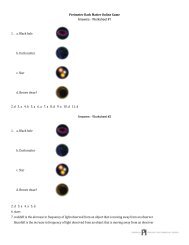Summary of Introductory Group Theory - Perimeter Institute
Summary of Introductory Group Theory - Perimeter Institute
Summary of Introductory Group Theory - Perimeter Institute
You also want an ePaper? Increase the reach of your titles
YUMPU automatically turns print PDFs into web optimized ePapers that Google loves.
<strong>Summary</strong> <strong>of</strong> <strong>Introductory</strong> <strong>Group</strong> <strong>Theory</strong><br />
Daniel Gottesman<br />
January 5, 2004<br />
1 Basic Definitions<br />
Definition 1. A group G is a set with a multiplication rule satisfying the following axioms:<br />
• Closure: g, h ∈ G =⇒ gh ∈ G.<br />
• Associativity: g, h, k ∈ G =⇒ (gh)k = g(hk).<br />
• Identity: ∃e ∈ G such that ∀g ∈ G, eg = ge = g. e is called the identity element <strong>of</strong> the group.<br />
• Inverse: ∀g ∈ G, ∃g −1 ∈ G such that gg −1 = g −1 g = e. g −1 is the inverse <strong>of</strong> g.<br />
An Abelian group satisfies the following additional axiom:<br />
• Commutativity: ∀g, h ∈ G, gh = hg.<br />
A group that is not Abelian is called a non-Abelian group.<br />
For Abelian groups, multiplication is sometimes written as addition, i.e., we write g + h instead <strong>of</strong> gh,<br />
the identity is written as 0, and the inverse <strong>of</strong> g is written as −g. For groups using multiplicative notation,<br />
the identity is sometimes written as 1.<br />
Examples <strong>of</strong> infinite Abelian groups include the integers or the real numbers (using addition as the group<br />
“multiplication”), or the real numbers without 0 using multiplication as the group multiplication.<br />
Exercise 1. The integers (even without 0) are not a group using multiplication. Why not? Why do we need<br />
to exclude 0 for the real numbers to be a group under multiplication?<br />
Some useful finite Abelian groups are the integers Z n modulo n under addition (that is, take the numbers<br />
0, . . . , n − 1 as the set, and group addition is defined by regular integer addition, taking only the remainder<br />
when the sum is divided by n). When n = p is prime, the integers (without 0) modulo p also form a group<br />
under multiplication, written Z ∗ n.<br />
Examples <strong>of</strong> finite non-Abelian groups are the permutation groups S n consisting <strong>of</strong> permutations <strong>of</strong> n<br />
(distinguishable) objects.<br />
Exercise 2. Show that S n is a group.<br />
We can also combine groups with a direct product structure by taking multiple copies <strong>of</strong> a group. The<br />
direct product G×H is the set consisting <strong>of</strong> pairs (g, h) with the multiplication rule (g, h)·(g ′ , h ′ ) = (gg ′ , hh ′ ).<br />
Definition 2. The order |G| <strong>of</strong> a finite group G is the number <strong>of</strong> elements in the underlying set.<br />
The order <strong>of</strong> Z n is n. The order <strong>of</strong> S n is n!.<br />
Definition 3. A field F is a set with two operations, addition and multiplication, with the following properties:<br />
• The field forms an Abelian group under addition.<br />
• The field without the additive inverse 0 forms an Abelian group under multiplication.<br />
1
• Distributivity: x, y, z ∈ F =⇒ x(y + z) = xy + xz.<br />
Examples <strong>of</strong> infinite fields are the real numbers, the rational numbers, and the complex numbers. Examples<br />
<strong>of</strong> finite fields are Z p , the integers modulo a prime p.<br />
An abstract vector space is an abelian group (written additively) with a scalar multiplication by elements<br />
<strong>of</strong> a field. A 1-dimensional vector space over the field F is just equal to F. The additive group for an n-<br />
dimensional vector space is the direct product <strong>of</strong> n copies <strong>of</strong> F.<br />
Definition 4. The direct product G × H <strong>of</strong> two groups G and H is formed from the set G × H <strong>of</strong> ordered<br />
pairs (g, h) (g ∈ G, h ∈ H) with multiplication rule (g, h) · (g ′ , h ′ ) = (gg ′ , hh ′ ).<br />
Exercise 3. Show that G × H is a group. What is the identity? What is the inverse <strong>of</strong> (g, h)?<br />
2 Subgroups<br />
Definition 5. A subgroup H <strong>of</strong> a group G is a subset <strong>of</strong> G which itself forms a group under the multiplication<br />
operation for G. That is, H is closed under multiplication and inverse, and contains the identity for G. The<br />
notation H ≤ G means that H is a subgroup <strong>of</strong> G.<br />
Any subgroup <strong>of</strong> the integers consists <strong>of</strong> multiples <strong>of</strong> some number. Thus, all even numbers form one<br />
subgroup <strong>of</strong> Z, and all numbers divisible by 25 form another subgroup. An example <strong>of</strong> a subgroup <strong>of</strong> S n is<br />
the set <strong>of</strong> cyclic permutations (starting from some particular ordering <strong>of</strong> the objects being permuted).<br />
Theorem 1 (Lagrange’s theorem). Suppose H ≤ G, with G and H finite groups. The order <strong>of</strong> G is a<br />
multiple <strong>of</strong> the order <strong>of</strong> H.<br />
Definition 6. The left coset gH <strong>of</strong> the subgroup H ≤ G (with g ∈ G) is the set {gh|h ∈ H}. The right<br />
coset Hg <strong>of</strong> H is the set {hg|h ∈ H}. In these cases g is called a coset representative for the left and right<br />
cosets gH and Hg.<br />
For groups written additively, we instead write g + H for a coset. Note that the coset eH = H and that<br />
gH = g ′ H iff g −1 g ′ ∈ H. Thus, the cosets <strong>of</strong> a subgroup partition the group G. Also note that each coset<br />
has the same number <strong>of</strong> elements as H; this proves Lagrange’s theorem.<br />
Note that only the coset <strong>of</strong> the identity is a subgroup <strong>of</strong> G.<br />
Definition 7. Suppose H ≤ G. H is a normal subgroup <strong>of</strong> G (written H ⊳ G) iff left cosets <strong>of</strong> H are equal<br />
to the corresponding right cosets <strong>of</strong> H. That is, ∀g ∈ G, gH = Hg.<br />
For an Abelian group, all subgroups are normal. For a non-Abelian group, normal subgroups tell us a<br />
great deal about the structure <strong>of</strong> the group and play a critical role in group theory. Some groups have no<br />
nontrivial normal subgroups. (The identity element forms a subgroup, which is always normal; the full group<br />
is also always a normal subgroup <strong>of</strong> itself.)<br />
Definition 8. The center Z(G) <strong>of</strong> the group G is the set <strong>of</strong> elements that commute with everything in the<br />
group: Z(G) = {h|gh = hg ∀g ∈ G}.<br />
Exercise 4. Prove that Z(G) ⊳ G.<br />
Definition 9. Let S ⊆ G be a set <strong>of</strong> group elements. Then the subgroup generated by S, sometimes denoted<br />
〈S〉, is the smallest subgroup containing S. That is, 〈S〉 consists <strong>of</strong> all (finite) products (in any order, when<br />
G is non-Abelian) <strong>of</strong> elements <strong>of</strong> S and their inverses. S is called a generating set for the subgroup 〈S〉. A<br />
group is cyclic if it has a single-element generating set.<br />
Thus, in the integers, 〈2〉, the subgroup generated by just the element 2, consists <strong>of</strong> all even numbers,<br />
whereas 1 generates the full group <strong>of</strong> integers. The integers and all the groups Z n are cyclic, since they each<br />
can be generated by the element 1.<br />
Exercise 5. Show that 〈6, 15〉, the subgroup <strong>of</strong> Z generated by 6 and 15, is equal to Z 3 , which consists <strong>of</strong> all<br />
numbers divisible by 3.<br />
Frequently we are interested in minimal generating sets for a group or subgroup — that is, sets for which<br />
removing even one element would mean generating a smaller group.<br />
2
3 Homomorphisms<br />
Definition 10. Let G and H be groups. A function f : G → H is a homomorphism iff ∀g, g ′ ∈ G, f(gg ′ ) =<br />
f(g)f(g ′ ).<br />
That is, a homomorphism is a function that preserves the group multiplication. Note that for a homomorphism<br />
f, f(e) = e and f(g −1 ) = [f(g)] −1 .<br />
For example, the homomorphisms from Z to Z are linear functions k ↦→ ck (for integer c, k). We can<br />
also have homomorphisms Z to Z n . For instance, the map “take the remainder <strong>of</strong> k modulo n” is such a<br />
homomorphism.<br />
Definition 11. A homomorphism f : G → H which has an inverse homomorphism f −1 (that is, f −1 :<br />
H → G such that f(f −1 (h)) = h ∀h ∈ H and f −1 (f(g)) = g ∀g ∈ G) is called an isomorphism. If there<br />
is an isomorphism from G to H, G and H are isomorphic. An isomorphism from G to itself is called an<br />
automorphism.<br />
Clearly isomorphic finite groups have the same order, so for instance, Z n and Z m are not isomorphic<br />
unless m = n, in which case there is an obvious isomorphism. However, there are also finite groups which<br />
have the same order but are not isomorphic. For instance, the direct product group Z 2 × Z 2 (which has<br />
order 4) is not isomorphic to the cyclic group Z 4 (which also has order 4).<br />
Definition 12. For any element h ∈ G, consider the map f h : G → G defined by f h (g) = hgh −1 . This is<br />
known as conjugation by h. The map f h is called an inner automorphism.<br />
Thus, an equivalent definition <strong>of</strong> a normal subgroup is a subgroup H for which f g (H) = H for all g ∈ G.<br />
The inner automorphisms are good examples <strong>of</strong> nontrivial automorphisms <strong>of</strong> a group (at least, they are<br />
generally non-trivial for a non-Abelian group).<br />
Exercise 6. Prove that f h is an automorphism from G to G. Show that the automorphism equals the identity<br />
iff h ∈ Z(G).<br />
Definition 13. Let f : G → H be a homomorphism. The kernel K(f) <strong>of</strong> f is the set {g ∈ G | f(g) = e}.<br />
Theorem 2. The kernel K(f) <strong>of</strong> any homomorphism is a normal subgroup <strong>of</strong> G.<br />
Exercise 7. Prove this.<br />
A more difficult and deep theorem is the converse:<br />
Theorem 3. Let N ⊳ G. Then there exists group H and homomorphism f : G → H such that N = K(f).<br />
To show this, we develop the notion <strong>of</strong> a quotient group:<br />
Definition 14. Let N ⊳ G. Then the quotient group G/N is the set <strong>of</strong> cosets <strong>of</strong> N with multiplication<br />
defined by (gN)(g ′ N) = (gg ′ )N.<br />
Theorem 4. G/N is a group. If G is Abelian, then so is G/N.<br />
Pro<strong>of</strong>. It’s not even immediately obvious that this multiplication rule is well-defined, but it is, because N is<br />
a normal subgroup: suppose we pick different coset representatives h ∈ gN and h ′ ∈ g ′ N (so gN = hN and<br />
g ′ N = h ′ N). Then we need to show that (gg ′ )N = (hh ′ )N; that is, that<br />
(gg ′ ) −1 (hh ′ ) = g ′−1 (g −1 h)h ′ ∈ N. (1)<br />
We know that n = g −1 h ∈ N. But since N is normal, g ′−1 N = Ng ′−1 . That means ∃n ′ ∈ N such that<br />
g ′−1 n = n ′ g ′−1 . (Note that n ′ may not be equal to n, however.) Thus,<br />
g ′−1 (g −1 h)h ′ = (g ′−1 n)h ′ = n ′ (g ′−1 h ′ ). (2)<br />
This is in N since n ′ ∈ N and g ′−1 h ′ ∈ N, and since N is a subgroup, and is therefore closed under<br />
multiplication.<br />
3
From here it is easy to verify the group axioms. Closure and associativity are pretty much trivial. The<br />
identity element <strong>of</strong> G/N is the coset <strong>of</strong> the identity eN. The inverse <strong>of</strong> a coset gN is the coset g −1 N. If G<br />
is Abelian, then<br />
(gN)(g ′ N) = (gg ′ )N = (g ′ g)N = (g ′ N)(gN). (3)<br />
This enables us to prove theorem 3. When N is a normal subgroup, there is a fairly obvious homomorphism<br />
from G to H = G/N, namely, g ↦→ gN.<br />
Exercise 8. Show that g ↦→ gN defines a homomorphism and show that N is the kernel <strong>of</strong> this map.<br />
Other interesting constructions are the normalizer and centralizer <strong>of</strong> a subgroup.<br />
Definition 15. The normalizer N G (H) <strong>of</strong> a subgroup H ≤ G is the largest subgroup <strong>of</strong> G for which H is a<br />
normal subgroup, H ⊳ N G (H). The centralizer Z G (H) <strong>of</strong> H in G is the largest subgroup <strong>of</strong> G for which all<br />
elements <strong>of</strong> H commute with all elements <strong>of</strong> Z G (H).<br />
Thus, for instance, if G is Abelian, N G (H) = Z G (H) = G.<br />
Exercise 9. Show that N G (H) = {g | g −1 hg ∈ H ∀h ∈ H} and Z G (H) = {g | g −1 hg = h ∀h ∈ H}. When is<br />
H ≤ N G (H)? When is H ≤ Z G (H)?<br />
4



